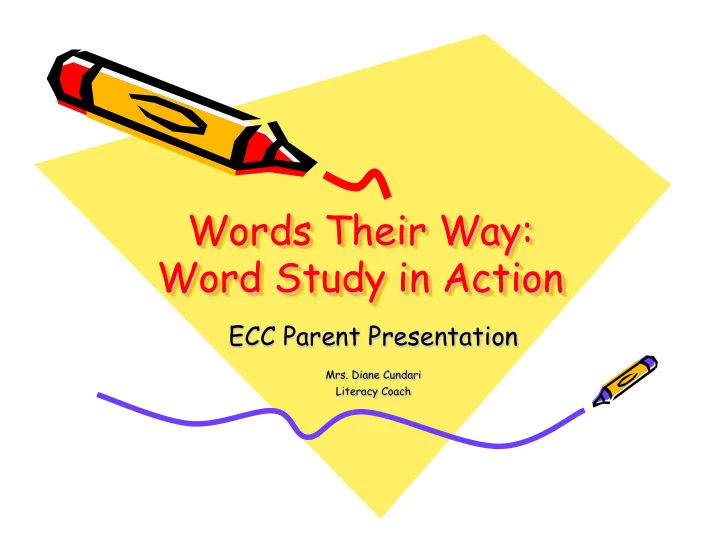

Words Their Way: Word Study in Action ECC Parent Presentation Mrs. Diane Cundari Literacy Coach
What is word study? • Part of a Balanced Literacy approach which includes Reading Workshop and Writing Workshop • Research-based system of learning that will improve phonics, spelling, and vocabulary • Differs from traditional spelling instruction in that does not rely on rote memorization • Uses hands-on activities such as picture and word sorting • Helps students to compare and contrast word features and discover similarities and differences within and between categories • Students become “word detectives”
Brain research suggests that students gain greater long term memory when they are… • Actively engaged • Manipulating ideas and objects • Using language to clarify and cement learning • Interacting with peers in directed academic conversations
Words Their Way: Word Study in Action • Words Their Way (WTW) is a developmental program. Students are grouped according to the results of a Primary Spelling Inventory, which is administered throughout the school year and used as a baseline. • Words Their Way follows the continuum of spelling development. Most students follow the same continuum, but possibly at different rates.
Sorting is the essential word study activity: Types • Sound Sort, Concept Sort or Spelling Sort of • Picture Sort, Letter Sort or Word Sort • Closed or Open Sort sorts: • Visual Sort, Blind Sort, Speed Sort or Writing Sort
Closed ¡Sort: ¡ ¡ ¡ Animals ¡ ¡ ¡ ¡ ¡ ¡ ¡ ¡ ¡ ¡ ¡ ¡ ¡ ¡ ¡ ¡ ¡ ¡Non-‑animals ¡ ?
Food, ¡Clothes ¡and ¡Toys ¡
Let’s ¡try ¡an ¡Open ¡Sort! ¡ • Spread ¡out ¡all ¡the ¡picture ¡cards ¡that ¡you ¡have ¡in ¡your ¡ pile. ¡ • Name ¡each ¡picture. ¡ • Sort ¡all ¡the ¡pictures ¡into ¡2 ¡or ¡3 ¡groups, ¡based ¡on ¡any ¡ category ¡that ¡you ¡choose. ¡ • Remember…you ¡will ¡be ¡asked ¡to ¡explain ¡your ¡reasons ¡ for ¡sorKng ¡the ¡pictures ¡the ¡way ¡you ¡chose. ¡ • When ¡you ¡are ¡finished ¡sorKng, ¡review ¡your ¡pictures ¡to ¡ be ¡sure ¡that ¡they ¡fit ¡into ¡each ¡category. ¡
Teachers would introduce each picture and define unfamiliar words such as mill, sill and rip.
Closed Sort for Word Families -‑ip ¡ -‑ig ¡ -‑ill ¡ zip pig wig Jill rip sill lip mill dig
What is your child doing in school? Day 1: Teacher introduces the words and sort to each small group. A rhyme or poem is shared to demonstrate the feature for this week’s sort. Day 2: Working in partners/small groups, students re-sort words in their Word Study notebooks. Day 3: Small group/partner work. Students practice word hunts using books from Words Their Way libraries or classroom books. Day 4: Students complete the Word Study skill page, resort and play games to practice this week’s feature. Day 5: At level K, there will be informal assessment and at level A, the assessment will be in the form of a weekly written test, which includes unassigned words. *Coding of the poem may continue throughout the week.
Practice at home: v Write this week’s words on index cards. Sort the word cards into categories (this type of sort has been taught at school). For example you might sort out all of the words that have “short a” in them or “long a.” Ask your child to explain to you why the words are sorted in a particular way. Sort the cards a second time as fast as possible (you may want to time your child). v Do a blind sort with your child. Lay down the category cards in a row. For example you would lay down the cards that indicate “long a” or “short a.” Then read a word card aloud, without showing it to your child. Without seeing the word, your child should point to the category that it goes in. Lay down the card. Your child should move it to the correct category if it is wrong. v Do a word hunt. Look for their words or words with the same sound pattern in books, magazines, or newspapers. v Have a practice test!
Words Their Way Language • Sorting – Organizing words into groups based on similarities in their patterns or meaning. • Oddballs – Words that cannot be grouped into any of the identified categories of a sort. Students should be taught that there are always words that “break the rules” and do not follow the general pattern. (Begins at Level B) • Sound marks / / - Sound marks around a letter or pattern tell the student to focus only on the sound rather than the actual letters. (Example: the word gem could be grouped into the /j/ category because it sounds like j at the beginning). • Vowel (represented by V) – One of 6 letters causing the mouth to open when vocalized (a, e, i, o, u, and usually y). A single vowel sound is heard in every syllable of a word. • Consonants (represented by C) – All the letters other than the vowels. Consonant sounds are blocked by the lips, tongue, or teeth during articulation. • Base words – A word to which prefixes or suffixes are added.
Websites for word study: (links available at www.palpkschools.org) • Spelling City: • http://www.spellingcity.com/ • Funbrain- online word games: • http://www.funbrain.com/words.html • Sadlier: • http://www.sadlier-oxford.com/phonics/student.cfm • Between the Lions: • http://pbskids.org/lions/games/ • Scholastic- rhyming games: • http://teacher.scholastic.com/activities/bll/reggie/index.htm • Roy the Zebra-interactive word games: • http://www.roythezebra.com/reading-games-word-level.html
Thank you for being a partner in your child’s education!
Recommend
More recommend